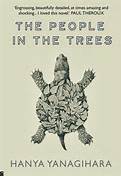 Published by Atlantic Books, 2 January 2014, UK
Published by Atlantic Books, 2 January 2014, UK
Doubleday, 13 August 2013, US
366pp, trade paperback, £12.99
Reviewed by Shirley Whiteside
Hanya Yanagihara, an American travel journalist, has loosely based her debut novel on the true story of controversial Nobel Prize-winning biologist, Dr Daniel Carleton Gajdusek. Gajdusek apparently discovered the cause of a rampant disease in New Guinea and helped to eradicate it. However his discovery was later publicly questioned and in the late 1990s he served twelve months in prison for molesting some of the young boys he brought back to America from the South Pacific to live with him.
Yanagihara’s novel takes the form of the memoirs of Dr Norton Perina, written while he serves a prison sentence for molesting some of the children he has adopted from the South Pacific. An introduction and strange footnotes are provided by D. Ronald Kubodera, Perina’s assistant and staunch defender. Perina relates his emotionally cold childhood and his medical studies but it is when he joins anthropologist Paul Tallent’s expedition to Ivu’ivu to find a fabled lost tribe that the novel takes off. Yanagihara’s descriptions of the flora and fauna of the island is a feast for the senses. The parrot-like green of the plants, the crunch of hundreds of insects underfoot, the twilight world under the dense jungle canopy, evoke an alien landscape. Perina and his companions pant through the thick air as they climb upwards toward the centre of the island, the slick of sweat coating their bodies. Yanagihara’s observations are intoxicating and could easily slip into purple prose but she navigates the precarious line with the confidence of a seasoned novelist.
Perina and Tallent find the lost tribe, known as The Dreamers, and are amazed by their longevity. This comes at a high price and Perina comments that The Dreamers look like humans but seem to have lost the ability to be human. Their consumption of a rare turtle seems to be the source of their long lives but it cannot protect them against senility. While Tallent is content to document the lives of The Dreamers, Perina seizes the opportunity to put himself on the scientific map. He captures one of the turtles and smuggles its meat back to America, astonishing the world with the results of his study of its properties. His discovery earns him a Nobel Prize and he is feted worldwide. But like The Dreamers, Westerners soon find that Perina’s discovery has horrific consequences.
Perina is not a likeable narrator. He is vain, unsympathetic and has a cruel streak, illustrated by his satisfaction in killing the mice used for experiments while earning his degree. It is a testament to Yanagihara’s skill in creating Perina that his story compels even while his character repels. There is a deep morality to the novel as big businesses move in on The Dreamers and their remote island. Questions about colonization and the price of cheating biology make for an involving read. There are hints of Shakespeare’s The Tempest in the insularity of Ivu’ivu but it is Perina and his quest for glory that dominate the novel. Yanagihara is an experienced travel writer and she draws on her day job to create a magical and somewhat disturbing story. This haunting, finely crafted debut marks her out as a novelist of great promise.
